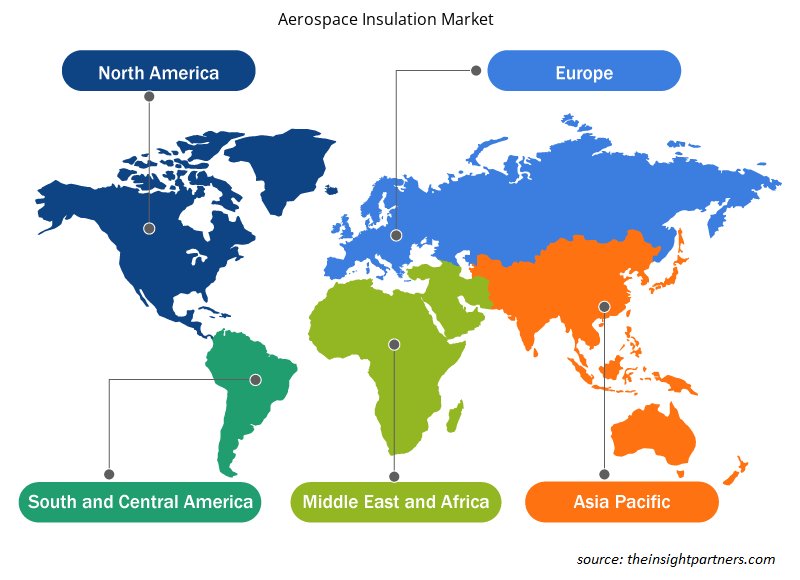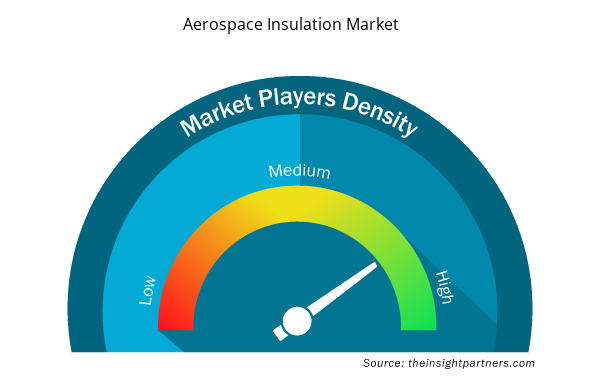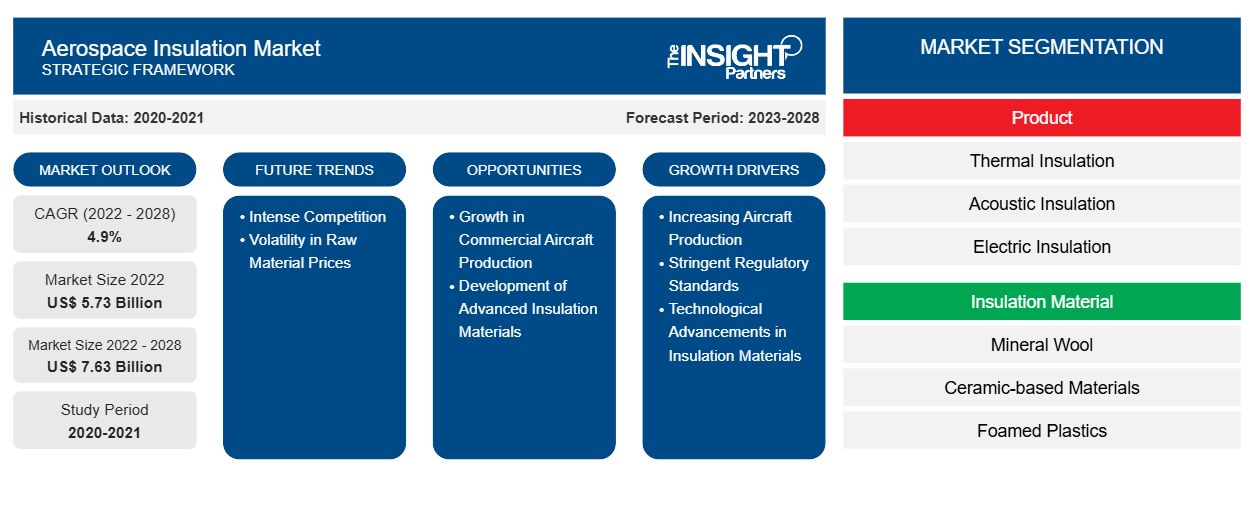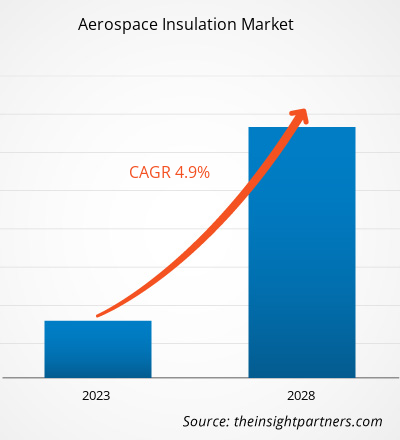Si prevede che il mercato dell'isolamento aerospaziale crescerà da 5.731,28 milioni di dollari nel 2022 a 7.633,23 milioni di dollari entro il 2028; si stima che crescerà a un CAGR del 4,9% dal 2022 al 2028.
L'isolamento aerospaziale si riferisce al materiale installato nell'aeromobile per migliorare i livelli di sicurezza e comfort. Le funzioni dell'aeromobile in condizioni climatiche severe devono rispettare determinate operazioni fondamentali e misure di sicurezza riguardanti sia i termini di peso e temperatura che le prestazioni complessive. Grazie ai vantaggi, come i minori livelli di vibrazione e rumore durante le ore di volo, la domanda di materiali isolanti sta crescendo a un ritmo rapido. Si prevede che il crescente utilizzo di materiali compositi negli aerei commerciali spingerà lo sviluppo di diverse aerostrutture, con conseguente potenziale industriale sostanziale. La crescente domanda di materiali isolanti leggeri e materiali compositi nei settori degli aerei commerciali e dei jet privati per ridurre il rumore in cabina guiderà probabilmente il mercato nei prossimi anni.
L'isolamento aerospaziale svolge un ruolo cruciale nella protezione dell'equipaggio e dei passeggeri dal rumore del generatore e dalle temperature gelide alle altitudini più elevate. La crescente domanda di aeromobili leggeri, di nuova generazione e a basso consumo di carburante, con la crescente importanza della riduzione delle emissioni, dovrebbe aumentare la produzione di aeromobili. Il significativo sviluppo del settore dei viaggi nei mercati emergenti e il crescente numero di passeggeri per viaggi internazionali e nazionali sono i principali fattori che guidano il mercato globale dell'isolamento aerospaziale . Ad esempio, secondo l'International Air Transport Association (IATA), la domanda totale di viaggi aerei ad aprile 2022 è aumentata del 78,7% rispetto ad aprile 2021.
Personalizza questo report in base alle tue esigenze
Riceverai la personalizzazione gratuita di qualsiasi report, comprese parti di questo report, o analisi a livello nazionale, pacchetto dati Excel, oltre a usufruire di grandi offerte e sconti per start-up e università
- Scopri le principali tendenze di mercato in questo rapporto.Questo campione GRATUITO includerà analisi di dati che spaziano dalle tendenze di mercato alle stime e alle previsioni.
Secondo la Federal Aviation Administration (FAA), tutti gli aerei commerciali devono avere un isolamento termico e acustico. Questi isolanti assicurano che il comfort dei passeggeri non sia influenzato dalle variazioni della temperatura esterna e che il rumore eccessivo creato dall'aereo non interferisca con la comunicazione. Tali severe normative incoraggiano i produttori di aeromobili a utilizzare materiale isolante negli aeromobili, dando impulso al mercato dell'isolamento aerospaziale.
Molti produttori di isolamento aerospaziale come Zotefoams stanno sviluppando materiali da costruzione aerospaziali leggeri per aumentare l'efficienza del carburante e la sostenibilità. L'isolamento termico e acustico protegge da rumore e temperatura eccessivi nella maggior parte degli aeromobili. L'isolamento termico e acustico è una fibra unica ad alte prestazioni racchiusa in una copertura in plastica classificata per aeromobili che tiene insieme i materiali isolanti e funge anche da barriera contro l'umidità.
Approfondimenti di mercato
La crescita nel settore del trasporto aereo stimola il mercato dell'isolamento aerospaziale
Il settore del trasporto aereo si sta espandendo rapidamente e si prevede che continuerà così nei prossimi anni. Secondo la stima dell'International Air Transport Association (IATA), si prevede che la domanda di trasporto aereo aumenterà in media del 4,3% all'anno fino al 2036. Se questa crescita verrà raggiunta entro il 2036, si prevede che il settore del trasporto aereo contribuirà a 15,5 milioni di posti di lavoro diretti e 1,5 trilioni di dollari di PIL all'economia mondiale durante il periodo di previsione. Una crescita così significativa della domanda di trasporto aereo porterà a una maggiore domanda di aeromobili. L'isolamento aerospaziale viene utilizzato negli aeromobili per aumentare il comfort e la sicurezza degli aeromobili e dei viaggiatori, il che dovrebbe far progredire il mercato dell'isolamento aerospaziale durante il periodo di previsione. Inoltre, il costo dei materiali compositi è in continuo calo, consentendo ai produttori di aeromobili di utilizzare i compositi per l'isolamento aerospaziale. Pertanto, a causa di tali fattori, il mercato prospererà rapidamente durante il periodo di previsione.
Approfondimenti sui prodotti
In base al prodotto, il mercato dell'isolamento aerospaziale è segmentato in isolamento termico, isolamento acustico, isolamento elettrico e isolamento dalle vibrazioni. Nel 2021, il segmento dell'isolamento termico ha dominato il mercato e si prevede che crescerà a un CAGR più rapido durante il periodo di previsione. Le maggiori attività di ricerca e sviluppo per produrre materiale di isolamento termico avanzato, leggero e sostenibile stanno stimolando la crescita del segmento dell'isolamento termico durante il periodo di previsione.
3M; TransDigm Group Incorporated; Triumph Group, Inc.; Johns Manville; Morgan Advanced Materials Plc; Polymer Technologies Inc.; Duracote Corporation; Rogers Corporation; DuPont; e BASF SE sono i principali attori che operano nel mercato dell'isolamento aerospaziale. I principali attori adottano diverse strategie, come fusioni e acquisizioni e lanci di prodotti, per espandere la loro presenza geografica e la base di consumatori.
Approfondimenti regionali sul mercato dell'isolamento aerospaziale
Le tendenze regionali e i fattori che influenzano il mercato dell'isolamento aerospaziale durante il periodo di previsione sono stati ampiamente spiegati dagli analisti di Insight Partners. Questa sezione discute anche i segmenti e la geografia del mercato dell'isolamento aerospaziale in Nord America, Europa, Asia Pacifico, Medio Oriente e Africa e America meridionale e centrale.

- Ottieni i dati specifici regionali per il mercato dell'isolamento aerospaziale
Ambito del rapporto sul mercato dell'isolamento aerospaziale
| Attributo del report | Dettagli |
|---|---|
| Dimensioni del mercato nel 2022 | 5,73 miliardi di dollari USA |
| Dimensioni del mercato entro il 2028 | 7,63 miliardi di dollari USA |
| CAGR globale (2022 - 2028) | 4,9% |
| Dati storici | 2020-2021 |
| Periodo di previsione | 2023-2028 |
| Segmenti coperti | Per Prodotto
|
| Regioni e Paesi coperti | America del Nord
|
| Leader di mercato e profili aziendali chiave |
|
Densità degli attori del mercato dell'isolamento aerospaziale: comprendere il suo impatto sulle dinamiche aziendali
Il mercato dell'isolamento aerospaziale sta crescendo rapidamente, spinto dalla crescente domanda degli utenti finali dovuta a fattori quali l'evoluzione delle preferenze dei consumatori, i progressi tecnologici e una maggiore consapevolezza dei vantaggi del prodotto. Con l'aumento della domanda, le aziende stanno ampliando le loro offerte, innovando per soddisfare le esigenze dei consumatori e capitalizzando sulle tendenze emergenti, il che alimenta ulteriormente la crescita del mercato.
La densità degli operatori di mercato si riferisce alla distribuzione di aziende o società che operano in un particolare mercato o settore. Indica quanti concorrenti (operatori di mercato) sono presenti in un dato spazio di mercato in relazione alle sue dimensioni o al valore di mercato totale.
Le principali aziende che operano nel mercato dell'isolamento aerospaziale sono:
- Società Duracote
- Società Rogers
- DuPont
- BASF SE
- 3 milioni
Disclaimer : le aziende elencate sopra non sono classificate secondo un ordine particolare.

- Ottieni una panoramica dei principali attori del mercato dell'isolamento aerospaziale
Segnala i riflettori
- Tendenze progressive nel settore dell'isolamento aerospaziale per aiutare gli operatori a sviluppare strategie efficaci a lungo termine
- Strategie di crescita aziendale adottate dalle aziende per garantire la crescita nei mercati sviluppati e in via di sviluppo
- Analisi quantitativa del mercato globale dell'isolamento aerospaziale dal 2021 al 2028
- Stima della domanda di isolamento aerospaziale in vari settori
- Analisi delle cinque forze di Porter per illustrare l'efficacia degli acquirenti e dei fornitori che operano nel settore dell'isolamento aerospaziale
- Sviluppi recenti per comprendere lo scenario competitivo del mercato e la domanda di isolamento aerospaziale
- Tendenze e prospettive di mercato, insieme ai fattori che regolano la crescita del mercato dell'isolamento aerospaziale
- Comprendere le strategie che sostengono l'interesse commerciale in relazione alla crescita del mercato, aiutando nel processo decisionale
- Dimensioni del mercato dell'isolamento aerospaziale in vari nodi di mercato
- Panoramica dettagliata e segmentazione del mercato nonché delle dinamiche del settore
- Dimensioni del mercato dell'isolamento aerospaziale in varie regioni con promettenti opportunità di crescita
"Aerospace Insulation Market Analysis to 2028" è uno studio specializzato e approfondito del settore dei prodotti chimici e dei materiali, incentrato sull'analisi delle tendenze di mercato. Il rapporto mira a fornire una panoramica del mercato con una segmentazione dettagliata. Il mercato dell'isolamento aerospaziale è segmentato in base a prodotto, materiale isolante, aeromobile e geografia. In base al prodotto, il mercato è segmentato in isolamento termico, isolamento acustico, isolamento elettrico e isolamento dalle vibrazioni. In base al materiale isolante, il mercato è segmentato in lana minerale, materiali a base di ceramica, plastica espansa, fibra di vetro e altri. In base agli aeromobili, il mercato è segmentato in motore e cellula. In base alla geografia, il mercato è segmentato in cinque regioni principali: Nord America, Europa, Asia Pacifico, Medio Oriente e Africa e Sud e Centro America. Nel 2021, il Nord America ha dominato il mercato. Tuttavia, si prevede che l'Asia Pacifico registrerà il CAGR più elevato nel mercato durante il periodo di previsione.
- Analisi storica (2 anni), anno base, previsione (7 anni) con CAGR
- Analisi PEST e SWOT
- Valore/volume delle dimensioni del mercato - Globale, regionale, nazionale
- Industria e panorama competitivo
- Set di dati Excel



Report Coverage
Revenue forecast, Company Analysis, Industry landscape, Growth factors, and Trends

Segment Covered
This text is related
to segments covered.

Regional Scope
North America, Europe, Asia Pacific, Middle East & Africa, South & Central America

Country Scope
This text is related
to country scope.
Domande frequenti
On the basis of aircraft, commercial aircraft is the fastest growing segment. It is growing at a CAGR of 5.0% during the forecast period 2022-2028. Commercial aircrafts pays more attention to the comfort of cabin to provide comfort to its customers, so to maintain a balance in weather inside the cabin it is covered with a layer of fiberglass insulation.
The major players operating in the global aerospace insulation market are Duracote Corporation, Rogers Corporation, DuPont, BASF SE, 3M, TransDigm Group Incorporated, Triumph Group Inc., Johns Manville, Morgan Advanced Materials Plc, and Polymer Technologies Inc.
The key factors that drive the aerospace insulation market include growing passenger & freight traffic in the world, a rise in MRO activities, and an increase in fleet replacement rates. The rising demand for lightweight fleet, new generation, and fuel-efficient aircraft with the increasing emphasis on reducing emissions is expected to drive aircraft production. The growth in the development of the travel industry in emerging markets, coupled with the increasing number of passengers for outbound and domestic travel, are some of the major factors driving the growth of aerospace insulation.
In 2021, the thermal insulation segment accounted for the largest market share. Lightweight fiberglass, insulation, and thin film bagging material make up aircraft thermal insulation. It is an insulation which is utilized all through an airplane’s fuselage: reduces noise, and protects from heat or cold.
In 2021, North America accounted for the largest share of the global aerospace insulation market. North America has a surge in demand for fuel-efficient engines. The largest aircraft delivers are also located in North America, along with the largest defense spending in the world. These factors are a reason that the region holds the largest share. The product manufacturers are also focusing on increased mergers to gain competitive edge.
On the basis of insulation material, ceramic-based materials is the fastest growing segment. It is expected to grow at a CAGR of 5.3% during the forecast period. The ceramic-based materials' applications make it suitable for aircraft and space exploration vehicles. They provide an electrical insulation, which acts as a very important factor in aircraft to avoid electromagnetic interference and makes the communication smoother between the pilot and ground control.
Trends and growth analysis reports related to Chemicals and Materials : READ MORE..
The List of Companies - Aerospace Insulation Market
- Duracote corporation
- Rogers Corporation
- DuPont
- BASF SE
- 3M
- TransDigm Group Incorporated
- Triumph Inc.
- Johns Manville
- Morgan Advanced Materials Plc
- Polymer Technolgoies Inc.
The Insight Partners performs research in 4 major stages: Data Collection & Secondary Research, Primary Research, Data Analysis and Data Triangulation & Final Review.
- Data Collection and Secondary Research:
As a market research and consulting firm operating from a decade, we have published and advised several client across the globe. First step for any study will start with an assessment of currently available data and insights from existing reports. Further, historical and current market information is collected from Investor Presentations, Annual Reports, SEC Filings, etc., and other information related to company’s performance and market positioning are gathered from Paid Databases (Factiva, Hoovers, and Reuters) and various other publications available in public domain.
Several associations trade associates, technical forums, institutes, societies and organization are accessed to gain technical as well as market related insights through their publications such as research papers, blogs and press releases related to the studies are referred to get cues about the market. Further, white papers, journals, magazines, and other news articles published in last 3 years are scrutinized and analyzed to understand the current market trends.
- Primary Research:
The primarily interview analysis comprise of data obtained from industry participants interview and answers to survey questions gathered by in-house primary team.
For primary research, interviews are conducted with industry experts/CEOs/Marketing Managers/VPs/Subject Matter Experts from both demand and supply side to get a 360-degree view of the market. The primary team conducts several interviews based on the complexity of the markets to understand the various market trends and dynamics which makes research more credible and precise.
A typical research interview fulfils the following functions:
- Provides first-hand information on the market size, market trends, growth trends, competitive landscape, and outlook
- Validates and strengthens in-house secondary research findings
- Develops the analysis team’s expertise and market understanding
Primary research involves email interactions and telephone interviews for each market, category, segment, and sub-segment across geographies. The participants who typically take part in such a process include, but are not limited to:
- Industry participants: VPs, business development managers, market intelligence managers and national sales managers
- Outside experts: Valuation experts, research analysts and key opinion leaders specializing in the electronics and semiconductor industry.
Below is the breakup of our primary respondents by company, designation, and region:

Once we receive the confirmation from primary research sources or primary respondents, we finalize the base year market estimation and forecast the data as per the macroeconomic and microeconomic factors assessed during data collection.
- Data Analysis:
Once data is validated through both secondary as well as primary respondents, we finalize the market estimations by hypothesis formulation and factor analysis at regional and country level.
- Macro-Economic Factor Analysis:
We analyse macroeconomic indicators such the gross domestic product (GDP), increase in the demand for goods and services across industries, technological advancement, regional economic growth, governmental policies, the influence of COVID-19, PEST analysis, and other aspects. This analysis aids in setting benchmarks for various nations/regions and approximating market splits. Additionally, the general trend of the aforementioned components aid in determining the market's development possibilities.
- Country Level Data:
Various factors that are especially aligned to the country are taken into account to determine the market size for a certain area and country, including the presence of vendors, such as headquarters and offices, the country's GDP, demand patterns, and industry growth. To comprehend the market dynamics for the nation, a number of growth variables, inhibitors, application areas, and current market trends are researched. The aforementioned elements aid in determining the country's overall market's growth potential.
- Company Profile:
The “Table of Contents” is formulated by listing and analyzing more than 25 - 30 companies operating in the market ecosystem across geographies. However, we profile only 10 companies as a standard practice in our syndicate reports. These 10 companies comprise leading, emerging, and regional players. Nonetheless, our analysis is not restricted to the 10 listed companies, we also analyze other companies present in the market to develop a holistic view and understand the prevailing trends. The “Company Profiles” section in the report covers key facts, business description, products & services, financial information, SWOT analysis, and key developments. The financial information presented is extracted from the annual reports and official documents of the publicly listed companies. Upon collecting the information for the sections of respective companies, we verify them via various primary sources and then compile the data in respective company profiles. The company level information helps us in deriving the base number as well as in forecasting the market size.
- Developing Base Number:
Aggregation of sales statistics (2020-2022) and macro-economic factor, and other secondary and primary research insights are utilized to arrive at base number and related market shares for 2022. The data gaps are identified in this step and relevant market data is analyzed, collected from paid primary interviews or databases. On finalizing the base year market size, forecasts are developed on the basis of macro-economic, industry and market growth factors and company level analysis.
- Data Triangulation and Final Review:
The market findings and base year market size calculations are validated from supply as well as demand side. Demand side validations are based on macro-economic factor analysis and benchmarks for respective regions and countries. In case of supply side validations, revenues of major companies are estimated (in case not available) based on industry benchmark, approximate number of employees, product portfolio, and primary interviews revenues are gathered. Further revenue from target product/service segment is assessed to avoid overshooting of market statistics. In case of heavy deviations between supply and demand side values, all thes steps are repeated to achieve synchronization.
We follow an iterative model, wherein we share our research findings with Subject Matter Experts (SME’s) and Key Opinion Leaders (KOLs) until consensus view of the market is not formulated – this model negates any drastic deviation in the opinions of experts. Only validated and universally acceptable research findings are quoted in our reports.
We have important check points that we use to validate our research findings – which we call – data triangulation, where we validate the information, we generate from secondary sources with primary interviews and then we re-validate with our internal data bases and Subject matter experts. This comprehensive model enables us to deliver high quality, reliable data in shortest possible time.


 Ottieni un campione gratuito per questo repot
Ottieni un campione gratuito per questo repot